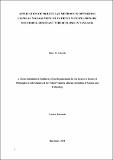| dc.description.abstract | Rifampicin or multidrug-resistant tuberculosis (RR/MDR-TB) accounts for considerable
morbidity and mortality. Differences among Mycobacterium tuberculosis complex (MTBC)
species may predict drug-resistance or treatment success. This thesis aimed at identifying
MTBC at species level, their drug-resistance patterns, and mycobactericidal effect of different
regimens in patients treated for RR/MDR-TB and drug-susceptible (DS-TB). This was a cross sectional study nested in a longitudinal design that followed patients on RR/MDR-TB and DS TB treatment for 4 months. While RR/MDR-TB patients received bedaquiline with or without
an injectable-aminoglycoside based regimen, DS-TB patients received a fixed-dose combination comprised of rifampicin-isoniazid-pyrazinamid-ethambutol (RHZE). The
genotype MTBC assay was used to identify MTBC species. WGS-based drug resistant
mutations predicted the minimum-inhibitory-concentration (MIC) of antibiotics measured in
the MycoTB-Sensitire™ assay. An isolate was categorised as resistant and susceptible if it had
a MIC above and at or below the epidemiological-cut-off (ECOFF) value, respectively. Non linear-mixed effects modelled the MTBC killing rates measured by Tuberculosis molecular bacterial load assay and culture. The median MIC at their 25th and 75th interquartile range (IQR)
were compared using Mann-Whitney U test. Among 126 patients, 89 (71%) had positive
culture whereas 87 (98%) were identified as M. tuberculosis. Overall, mutant (gNWT-R)
MTBC isolates correlated with MIC values above the ECOFF. For instance, the median MIC
(µg/mL) for rifampicin-gNWT-R strains was > 4.0 (IQR; 4.0 – 4.0) compared to 0.5 (IQR; 0.38
– 0.50) in non-mutant (gWT-S, p < 0.001); isoniazid-gNWT-R > 4.0 (IQR; 2.0 – 4.0) compared
to 0.25 (IQR; 0.12 – 1.00) among gWT-S (p = 0.001); ethionamide-gNWT-R 15.0 (IQR; 10.0
– 20.0) compared to 2.50 (IQR; 2.50 – 5.00) among gWT-S (p < 0.001). There were no
detectable mutations in genes previously known to confer fluoroquinolones, aminoglycosides,
capreomycin, bedaquiline, delamanid, linezolid, clofazimine, cycloserine, and p aminosalicylic acid resistance. Compared to the adjusted M. tuberculosis killing rate of -0.17
(95% CI; -0.23 to -0.12) for the injectable without bedaquiline reference regimen, the killing
rates were -0.62 (95% CI; -1.05 to -0.20) log10 eCFU/mL for the injectable with bedaquiline containing regimen (p = 0.019), -0.35 (95% CI; -0.65 to -0.13) log10 eCFU/mL for the all-oral
bedaquiline-based regimen (p = 0.054), and -0.29 (95% CI; -0.78 to +0.22) log10 eCFU/mL
for RHZE (p = 0.332). The detected M. tuberculosis was susceptible to core drugs including
bedaquiline, fluoroquinolones, linezolid, and clofazimine, supporting their central use in the
RR/MDRTB treatment regimens. M. tuberculosis killing rates were higher among patients who
received bedaquiline but were further improved with addition of an injectable aminoglycoside. | en_US |

